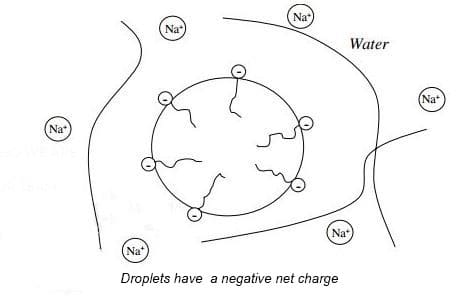

Fig : Typical anionic bitumen emulsion
Overview
Anionic bitumen emulsion in which the droplets of bitumen are negatively charged. In an electric field, particles of bitumen migrate to form anionic bitumen emulsion. Since the droplets migrate toward the anode (positive electrode), the emulsion is called anionic. An anionic emulsion contains “billions and billions” of bitumen droplets with the emulsifying agent at the water-bitumen interface. In the tail of the emulsifying agent, the positive portion aligns itself in the bitumen while the rest of the head, which is negatively charged, floats around in the water. The droplets acquire a negative charge as a result. The negatives repel each other, so all the drops repel each other and remain as distinct bitumen drops in suspension.
The most common anionic emulsifiers are acids, which are wood-product derivatives such as tall oils, rosins, and lignins. Anionic emulsifiers are saponified (turned into soap) by reacting with sodium hydroxide or potassium hydroxide.
Bitumen emulsions are further classified on the basis of how quickly the asphalt droplets will coalesce; (i.e., revert to asphalt cement). The terms RS, MS, SS, and QS have been adopted to simplify and standardize this classification. They are relative terms only and mean rapid-setting, medium-setting, slow-setting, and quick-setting. The tendency to coalesce is closely related to the speed with which an emulsion will become unstable and break after contacting the surface of an aggregate. An RS emulsion has little or no ability to mix with an aggregate, a NIS emulsion is expected to mix with coarse but not fine aggregate, and SS and QS emulsions are designed to mix with fine aggregate, with the QS expected to break more quickly than the SS.
Emulsions are further identified by a series of numbers and letters related to the viscosity of the emulsions and the hardness of the base asphalt cement. The letter “C” in front of the emulsion type denotes cationic. The absence of the “C” denotes anionic in American Society for Testing and Materials (ASTM) and American Association of State Highway and Transportation Officials (AASHTO) specifications. For example, RS-1 is anionic and CRS-I is cationic.


Fig : Chemical Set of Bitumen Emulsion
Breaking Characteristics of Anionic Bitumen Emulsion
Emulsions facilitate application. Asphalt cement should evaporate after application. After the emulsion and aggregate have been applied to the road surface, the emulsion should “break” leaving the asphalt cement holding the aggregate. At that point, traffic can be allowed on the surface without loss of aggregate. Emulsion type has a large effect on how quickly an emulsion breaks.
The net charge on almost every surface is negative. Depending on the material, the strength or intensity of the negative charge may vary. Anionic and cationic emulsions break differently because of this phenomenon.
A negatively charged drop of asphalt is applied to a negatively charged surface in an application of anionic emulsion. Each component repels the other. An emulsion can only be broken by the loss of water by evaporation. During the process of evaporation, the particles are forced closer and closer together until they can no longer be separated by a film of water. A sheet of asphalt eventually forms on the road when droplets coalesce into larger and larger drops.
| Anionic Emulsion | RS | RS-1 |
| RS-2 | ||
| MS | MS-2 | |
| MS-2h | ||
| HFMS-1 | ||
| HFMS-2 | ||
| HFMS-2h | ||
| HFMS-2s | ||
| SS | SS-1 | |
| SS-1h |
RAPID SETTING EMULSION (RS)
- Designed to react quickly with aggregate and revert from the emulsion to the asphalt.
- Primarily used for spray applications.
MEDIUM SETTING EMULSION (MS)
- Designed for mixing with graded aggregate.
- Formulated not to break immediately upon contact with aggregate and will remain workable for a few minutes to several months depending upon the formulation
- Primarily used in pugmills.
SLOW SETTING EMULSION (SS)
- Designed for mixing stability.
- Primarily used with high fine content aggregates, tack coats, fog seals and dust palliatives.
Get in touch
Your Gateway to Top-Quality Bitumen
Elevate your projects with Gulf Bitumen’s superior quality and expertise. Contact us now to access top-notch bitumen solutions tailored to your needs.
